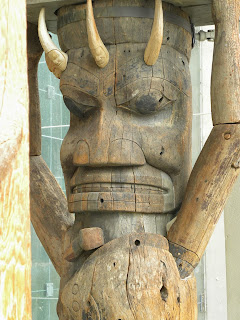The Museum of Anthropology (MOA) at the University of British Columbia is a very interesting place to visit. There is an extensive collection in the museum as well as an outdoor collection including many totem poles and a long house.
I took these pictures when I last visited:
Welcoming poles outside:
Outside the Museum of Anthropology:
"Totem poles may recount familiar legends, clan lineages, or notable events. Some poles celebrate cultural beliefs, but others are mostly artistic. Certain types of totem poles are part of mortuary structures, and incorporate grave boxes with carved supporting poles, or recessed backs for grave boxes. Poles illustrate stories that commemorate historic persons, represent shamanic powers, or provide objects of public ridicule." (Wikipedia)
Poles are usually carved of western red cedar because it is resistant to decay (containing a natural fungicide), but still there are not many poles that are more than 100 years old still standing.
"The vertical order of images is widely believed to be a significant representation of importance. This idea is so pervasive that it has entered into common parlance with the phrase "low man on the totem pole." " (Wikipedia)
"Erection of a totem pole is almost never done using modern methods, even for poles installed in modern settings on the outside of public and private buildings. Instead, the traditional ceremony and process of erection is still followed scrupulously by most artists, in that a great wooden scaffold is built, and hundreds of strong men haul the pole upright into its footing, while others steady the pole from side ropes and brace it with cross beams.
Once the pole is complete, a potlatch is typically held where the carver is formally paid and other traditional activities are conducted. The carver will usually, once the pole is freestanding, perform a celebratory and propitiatory dance next to the pole while wielding the tools used to carve it. Also, the base of the pole is burnt before erection to provide a sort of rot resistance." (Wikipedia)
"Totem poles are typically not well maintained after their erection.
The beliefs behind the lack of maintenance vary among individuals, but generally it is believed that the deterioration of the pole is representative of natural processes of decay and death that occur with all living things, and attempts to prevent this are seen as somehow denying or ignoring the nature of the world." (Wikipedia)
Inside the museum is a huge collection of art from cultures around the world.
MOA describes itself as: "A place of extraordinary architectural beauty. A place of provocative programming and vibrant, contemporary exhibitions. A place of active exploration and quiet contemplation. A place of world arts and cultures."
Bill Reid's sculpture "The Raven and the First Men":
Cooking box lids:
I have always been fascinated by the imagery on totem poles and other First Nations' carvings and I sure found some inspiration in my visit to the MOA.
Here are two paintings that I have finished recently.
Both are watercolours; the first I call "Aurora":
Both are part of my art show at "Pane e Formaggio", on now until early November.
For more information on these paintings or others in my show visit GillianOlsonArt.blogspot.com
Thank you for stopping by, yours with whimsy, Gillian.



























